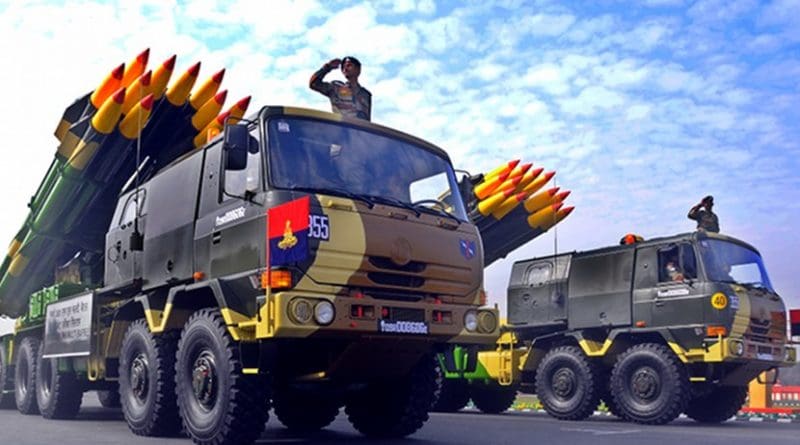Still No Bullseye, In Volume And Value – Analysis
By Observer Research Foundation
India’s defence model faces challenges despite the positive trends generated by ‘Make in India’.
By Harsh V. Pant and Kartik Bommakanti
The emergence of evidence of a rise in Indian defence exports, also accompanied by a decline in imports, is a welcome development though the reasons for both are not identical. Based on the latest estimates released by the Stockholm International Peace Research Institute (SIPRI) in the period between 2009-13 and 2014-18, Indian defence imports fell even as exports increased.
Broadly, two factors appear to be driving this shift. The first is the ‘Make in India’ initiative, as part of which a number of components from Indian private and public sector enterprises have been prioritised by the government. The second set of factors is extraneous to India in the form of delays in supplying equipment by vendors and the outright cancellation of contracts by the Indian government or at least a diminution of existing contracts.
Under the Narendra Modi government’s ‘Make in India’ initiative, the Defence Procurement Procedure (DPP) lays out the terms, regulations and requirements for defence acquisitions as well as the measures necessary for building India’s defence industry. It created a new procurement category in the revised DPP of 2016 dubbed ‘Buy Indian Indigenously Designed, Developed and Manufactured’ (IDDM). The ‘Make’ procedure has undergone simplification “earmarking projects not exceeding ten crores” that are government funded and ₹3 crore for Micro, Small and Medium Enterprises (MSMEs) that are industry funded. In addition, the government has also introduced provisions in the DPP that make private industry production agencies and partners for technology transfers. Small and Medium Enterprises (SMEs) until 2016 accounted for a 17.5% share of the Indian defence market. According to government of India data for the financial year 2018-19, the three armed services for their combined capital and revenue expenditures sourced 54% of their defence equipment from Indian industry.
Public sector driven
Among arms producers, India has four companies among the top 100 biggest arms producers of the world. It is estimated, according to SIPRI, their combined sales were $7.5 billion in 2017, representing a 6.1% jump from 2016. The largest Indian arms producers are the Indian ordnance factories and the Hindustan Aeronautics Limited (HAL), which are placed 37th and 38th, respectively, followed by Bharat Electronics Limited (BEL) and Bharat Dynamics Limited (BDL). All four of these companies are public sector enterprises and account for the bulk of the domestic armament demand.
Explaining falling imports
To be sure, not all this growing indigenisation and reduction in imports can be attributed to ‘Make in India’. Indian defence acquisitions have also fallen due to the cancellation of big-ticket items. Take for instance the India-Russia joint venture for the development of the advanced Su-57 stealth Fifth Generation Fighter Aircraft (FGFA). India cancelled involvement in 2018 due to rising dissatisfaction in delays with the project as well as the absence of capabilities that would befit a fifth generation fighter jet. In 2015, the Modi government also reduced the size of the original acquisition of 126 Rafale Medium Multi-Role Combat Aircraft (MMRCA) from Dassault to 36 aircraft, which is also responsible for significantly driving down the import bill. That apart, the delays in the supplies of T-90 battle tanks, and Su-30 combat aircraft from Russia and submarines from France, in 2009-13 and 2014-18, also depressed imports.
Further, India’s defence model faces challenges despite the positive trends generated by ‘Make in India’. SMEs still face stunted growth because India’s defence industrial model is at odds with global trends in that it tends to create disincentives for the private sector. Governments, including the incumbent, have tended to privilege Defence Public Sector Units (DPSUs) over the private sector, despite ‘Make in India’. This model is highly skewed, undermining the growth of private players and diminishes the strength of research and development.
Export trends
Nevertheless, on the exports front, trends do look promising. Indeed, the period between 2012 and 2019 saw Indian defence exports experiencing a considerable jump sourced from Indian public and private sector enterprises. In the last two fiscal years, 2017-18 and 2018-19, exports have witnessed a surge from ₹7,500 crore to ₹11,000 crore, representing a 40% increase in exports. While this initial increase started during the previous United Progressive Alliance (UPA) government, the sharpest rise in defence export products can be attributed to the measures introduced by the National Democratic Alliance (NDA) government under Mr. Modi, which in 2014, delisted or removed several products that were restricted from exports. It dispensed with the erstwhile No Objection Certificate (NOC) under the DPP restricting exports of aerospace products, several dual-use items and did away with two-thirds of all products under these heads. According to the Ministry of Commerce and the Industry, Export-Import Data Bank export of defence items in the aerospace category has witnessed an increase in value. Small naval crafts account for the bulk of India’s major defence exports. However, export of ammunition and arms remain low. As a percentage of total Indian trade, defence-related exports for the fiscal years 2017-18 and 2018-19 were 0.8 and 0.73%, respectively.
Thus, from a volume and value standpoint, Indian defence exports, while showing a promising upward trend, still remain uncompetitive globally. It is likely that Indian defence exports will take several years before they are considered attractive by external buyers. But green shoots are emerging in a sector that has long been devoid of any dynamism and Indian policymakers should make the most of the opportunities this represents.
This article originally appeared in The Hindu.

